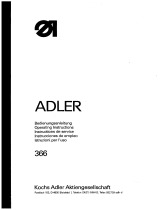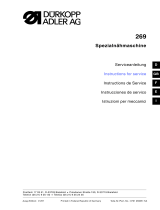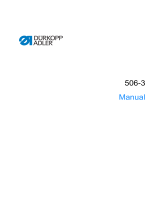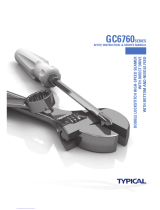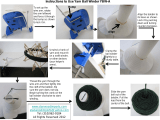Page is loading ...

868
Operating Instructions

All ri
g
hts reserved.
Property of Dürkopp Adler GmbH and copyrighted. Reproduction or publication of the content in any
manner, even in extracts, without prior written permission of Dürkopp Adler GmbH, is prohibited.
Copyright © Dürkopp Adler GmbH - 2020

Foreword
This instruction manual is intended to help the user to become familiar
with the machine and take advantage of its application possibilities in
accordance with the recommendations.
The instruction manual contains important information on how to
operate the machine securely, properly and economically. Observation
of the instructions eliminates danger, reduces costs for repair and
down-times, and increases the reliability and life of the machine.
The instruction manual is intended to complement existing national
accident prevention and environment protection regulations.
The instruction manual must always be available at the machine/sewing
unit.
The instruction manual must be read and applied by any person that is
authorized to work on the machine/sewing unit. This means:
– Operation, including equipping, troubleshooting during the work
cycle, removing of fabric waste,
– Service (maintenance, inspection, repair) and/or
– Transport.
The user also has to assure that only authorized personnel work on the
machine.
The user is obliged to check the machine at least once per shift for
apparent damages and to immediatly report any changes (including the
performance in service), which impair the safety.
The user company must ensure that the machine is only operated in
perfect working order.
Never remove or disable any safety devices.
If safety devices need to be removed for equipping, repairing or
maintaining, the safety devices must be remounted directly after
completion of the maintenance and repair work.
Unauthorized modification of the machine rules out liability of the
manufacturer for damage resulting from this.
Observe all safety and danger recommendations on the machine/unit!
The yellow-and-black striped surfaces designate permanend danger
areas, eg danger of squashing, cutting, shearing or collision.
Besides the recommendations in this instruction manual also observe
the general safety and accident prevention regulations!

General safety instructions
The non-observance of the following safety instructions can cause
bodily injuries or damages to the machine.
1. The machine must only be commissioned in full knowledge of the
instruction book and operated by persons with appropriate training.
2. Before putting into service also read the safety rules and
instructions of the motor supplier.
3. The machine must be used only for the purpose intended. Use of
the machine without the safety devices is not permitted. Observe all
the relevant safety regulations.
4. When gauge parts are exchanged (e.g. needle, presser foot, needle
plate, feed dog and bobbin) when threading, when the workplace is
left, and during service work, the machine must be disconnected
from the mains by switching off the master switch or disconnecting
the mains plug.
5. Daily servicing work must be carried out only by appropriately
trained persons.
6. Repairs, conversion and special maintenance work must only be
carried out by technicians or persons with appropriate training.
7. For service or repair work on pneumatic systems, disconnect the
machine from the compressed air supply system (max. 7-10 bar).
Before disconnecting, reduce the pressure of the maintenance unit.
Exceptions to this are only adjustments and functions checks made
by appropriately trained technicians.
8. Work on the electrical equipment must be carried out only by
electricians or appropriately trained persons.
9. Work on parts and systems under electric current is not permitted,
except as specified in regulations DIN VDE 0105.
10. Conversion or changes to the machine must be authorized by us
and made only in adherence to all safety regulations.
11. For repairs, only replacement parts approved by us must be used.
12. Commissioning of the sewing head is prohibited until such time as
the entire sewing unit is found to comply with EC directives.
13. The line cord should be equipped with a country-specific mains
plug. This work must be carried out by appropriately trained
technicians (see paragraph 8).
It is absolutely necessary to respect the safety
instructions marked by these signs.
Danger of bodily injuries !
Please note also the general safety instructions.

Contents Page:
Preface and general safety instructions
Part 1: Operating Instructions Class 868 – Original Instructions
(Edition 03/2011)
1 Product description ............................................ 5
2 Designated use ............................................... 5
3 Subclasses .................................................. 6
4 Optional equipment............................................. 8
5 Technical data
5.1 Technicaldatasubclasses......................................... 11
6 Operation
6.1 Threadingtheneedlethread........................................ 13
6.2 Adjustingtheneedle-threadtension................................... 15
6.2.1 Function of the thread main tension and the thread supplementary tension in relation
tothesewingfootlifting .......................................... 16
6.2.2 Reparationseamwiththreadtensionalwaysclosed ......................... 16
6.2.3 Function of the thread’s supplementary tension in relation to the stroke adjustment
andtheSpeedomat ............................................. 17
6.3 Openingthethreadtension......................................... 17
6.4 Shortstitch .................................................. 18
6.4.1 Shortstitchattheseambeginning.................................... 18
6.4.2 Shortstitchattheendofaseam..................................... 18
6.4.3 Shortstitchattheseambeginningandseamend........................... 18
6.5 Switching the supplementary tension on and off with machines without thread trimmer .... 19
6.6 Adjustingthethreadregulator....................................... 20
6.7 Winding on the hook thread ........................................ 21
6.8 Changing the hook-thread bobbin .................................... 22
6.9 Setting the hook thread tension ...................................... 23
6.10 Insertingandchangingtheneedlewithsingle-needlemachines.................. 24
6.11 Insertingandchangingtheneedlewithdouble-needlemachines.................. 25
6.12 Liftingthesewingfoot............................................ 26
6.13 Lockingthesewingfeetinliftedposition ................................ 27
6.14 Sewing-footpressure............................................ 27
6.15 Sewing-footstroke.............................................. 28
6.16 Settingthestitchlength........................................... 30
6.17 Keypadonthemachinearm........................................ 31
7 Sewing drive and operating panel ................................... 32
8Sewing..................................................... 33

Contents Page:
9 Maintenance
9.1 Cleaningandtesting............................................. 35
9.2 Lubrication................................................... 37
10 Optional equipment
10.1 Seamcenterguide.............................................. 38
10.2 Repair ..................................................... 39

1 Product description
The DÜRKOPP ADLER 868 is a special sewing machine for universal
use.
·
It is a flatbed double-lockstitch machine with bottom feed, needle
feed and alter nating upper foot feed.
·
Depending on the subclass it comes as single or double needle
automat, with or without electromagnetic thread cutter, with or
without edge trimmer.
·
Equipped with a large or oversized two-piece vertical hook.
·
With a maximum of 20 mm fabric clearance when sewing feet are
lifted.
·
A safety clutch prevents a changing of the hook setting or a hook
damage in the case of a thread deflection into t he shuttle track.
·
Automatic wick lubricating with an inspection glass on the arm for
machine and hook lubrication.
·
Integrated winder.
2 Designated use
The 8
68 class is a sewing machine designed for sewing light to medium-
heavy material. Such material is generally made of textile fibers, but it
may also be leather. It is used in the clothing industry and for domestic
and motor-vehicle upholstery.
This special sewing machine can also be used to produce so-called
technical seams. In this case, however, the operator must assess the
possible dangers which may arise (with which DÜRKOPP ADLER GmbH
would be happy to assist), since such applications are on the one hand
relatively unusual and, on the other, so varied that no single set of
criteria can cover them all. The outcome of this assessment may require
appropriate safety measures to be taken.
Generally only dry material may be sewn with this machine. The material
may be no thicker than 10 mm when compressed by the lowered sewing
feet. The material may not contain any hard objects, since if it does the
machine may not be operated without an
eye-protection device. No such device is currently available.
The seam is generally produced with textile-fibre sewing thread of gauge
up to 11/3 NeB (cotton), 11/3 Nm (synthetic) or 11/4 Nm
(covering yarn).
Before using any other thread the possible dangers arising must be
assessed and appropriate safety measures taken if necessary.
5

This special sewing machine may be set up and operated only
in dry, well-maintained premises. If the sewing machine is used in
premises which a re not dry and well-maintained it may be
necessary to take further precautions, which should be agreed upon in
advance (see EN 60204-31:1999).
As manufacturers of industrial sewing machines we proceed on the
assumption that personnel who work on our products will have
received training at least sufficient to acquaint them with all normal
operations and with any hazards which these may involve.
3 Subclasses
868-190020 Single-needle double-lockstitch post bed machine
with bottom feed, needle feed, alter nating upper
foot feed and large hook.
867-290020 Double-needle double-lockstitch post bed machine
with bottom feed, needle feed, alter nating upper
foot feed and large hook.
868-190322 Single-needle double-lockstitch post bed machine
with bottom feed, needle feed, alter nating upper
foot feed, electro-pneumatic rapid stroke
adjustment with automatic speed limitation,
operated via knee lever, electro-magnetic thread
cutter, electro-pneumatic seam bartacking,
electro-pneumatic second stitch length and sewing
foot lifting. With large hook, with integrated s ewing
lamp.
Function keys for: manually sewing backward,
needle high/low/single stitch, switching on/off of the
bartack, 2nd stitch length, switching on/off of the
supplementary thread tension .
868-290322 Double-needle double-lockstitch post bed machine
with bottom feed, needle feed, alter nating upper
foot feed, electro-pneumatic rapid stroke
adjustment with automatic speed limitation,
operated via knee lever, electro-magnetic thread
cutter, electro-pneumatic seam bartacking,
electro-pneumatic second stitch length and sewing
foot lifting. With large hook, with integrated s ewing
lamp.
Function keys for: manually sewing backward,
needle high/low /single stitch, switching on/off of
the bartack, 2nd stitch length, switching on/off of
the supplementary thread tension.
6

868-390322 Double-needle double-lockstitch post bed machine
with bottom feed, needle feed, alter nating upper
foot feed, electro-pneumatic rapid stroke
adjustment with automatic speed limitation,
operated via knee lever, electro-magnetic thread
cutter, electro-pneumatic seam bartacking,
electro-pneumatic second stitch length and sewing
foot lifting. With large hook, with integrated s ewing
lamp.
Left post.
Function keys for: manually sewing backward,
needle high/low /single stitch, switching on/off of
the bartack, 2nd stitch length, switching on/off of
the supplementary thread tension.
7

4 Optional equipments
For the 868 the following optional equipments are available:
Order No. Optional equipment Subclasses
868-190020
868-290020
868-190322
868-290322
868-390322
0867 590014 Electro-pneumatic needle cooler x
from the top
0867 590064 Pneumatic connection x x x x x
9780 000108 WE-8 maintenance unit for pneumatic
optional equipments x x o o o
9822 510003 Halogen sewing lamp x x x x x
9880 867100 Sewing lamp add-on kit x x x x x
0798 500088 Sewing lamp transformer x x x x x
9880 867103 Sewing lamp LED x x x x x
9880 867102 Integrated sewing lamp LEDs x x o o o
9850 001089 Power supply complete for x x o o o
integrated sewing lamp LEDs
N800 080001 Edge guide, swivelling x x
N800 080004 Roller stop x x
N800 080021 Edge guide, swivelling x x
N800 005650 Seam center guide x x
N800 005655 Seam center guide, swivelling x x
No. according Tape guide with tape-reel bracket x x
to the band size
9805 791113 USB memory key
for transferring data with the x x x x x
Efka control unit DA321G
0797 003031 Pneumatic connection package x x x x
0867 590354 Pneumatic sewing foot lifting x x
Stands
MG55 400364 Stand set MG 55-3 x x x x x
for motor fitting beneath the table,
with pedal
Table t op size 1060 x 600 mm
MG55 400374 Stand set MG 55-3 x x x
for motor fixed on machine head,
with Pedal
Table top size 1060 x 600 mm
x = Optional equipment
o = Standard equipment
8

Please contact our Application Center (APC) for further optional
equipment.
E-Mail: marketing@duerkopp-adler.com
Further available documents concer ning the class 868:
0791 868801 Parts list
0791 868641 Service Instructions
0791 100700 Fitting Instructions for Sewing Lamp LED
0791 867701 Instructions for fitting seam center guide
N800 005655 (mechanically)
N800 005650 (pneumatically)
0791 867704 Instructions for fitting pneumatic
sewing foot lift
0791 867705 Instructions for fitting for edge guide N800 080021
9

5 Technical data
Noise: Workplace-related emission value in accordance with DIN 45635-48-A-1-KL2
868-190020 LC = _dB (A)
Stitch length: _ mm Sewing foot stroke: mm Speed: ____ min
-1
Material:
868-290020 LC = _dB (A)
Stitch length: _ mm Sewing foot stroke: mm Speed: ____ min
-1
Material:
868-190322 LC = _dB (A)
Stitch length: _ mm Sewing foot stroke: mm Speed: ____ min
-1
Material:
868-290322 LC = _dB (A)
Stitch length: _ mm Sewing foot stroke: mm Speed: ____ min
-1
Material:
868-390322 LC = _dB (A)
Stitch length: _ mm Sewing foot stroke: mm Speed: ____ min
-1
Material:
10

5.1 Technical data subclasses
868-190020
868-190322
868-290020
868-290322
868-390322
Type of stitch Lockstitch 301
Hook type
large
large
large
large
large
Number of needles 1 2 1 2 1
Needle system 134-35
Needle size 170
(depending on E-No.) [Nm]
Max. thread thickness [Nm] 10 / 3
Stitch length [mm]
- Forward 12
- Backward 12
Number adj. stitch lengths 1 2 1 2 2
Max. speed [min
-1
] 2500 2500 2500 2500 2500
Speed with
factory setting [min
-1
] 2500 2500 2500 2500 2500
Max. lifting height [mm] 20* 20* 20* 20* 20*
(*only with tur n-back device)
Max. sewing foot stroke [mm] 9 9 9 9 9
Operating pressure [bar] - 6 - 6 6
Air consumption per
working cycle [NL] - 0,7 - 0,7 0,7
Dimensions (H x W x D) [mm] 690 / 220 / 640
Weight 68 68 70 70 68
with direct drive [kg] - 72 - 74 72
11

Threading scheme single-needle machine
Threading scheme double-needle machine
-
12
1
2
3
4
5
11
10
9
8
7
6
12
13
14
15
16
22
21
20
19
18
17
0868 190xxx 0868 390xxx

6 Operation
6.1 Threading the needle thread
Caution: danger of injury !
Turn off the main switch.
The needle thread may only be threaded with the sewing machine
switched off.
–
Put the thread reel on the thread stand and lead the needle thread
through the unwinder arm.
The unwinder arm must be in vertical position above the thread
reels.
–
Thread in the thread through threading guide 1 and 2.
–
Conduct the thread clockwise around the pre-tensioner wheel 3.
–
Conduct the thread counter-clockwise around the supplementary
tensioner wheel 4.
–
Conduct the thread clockwise around the main tensioner wheel 5.
–
Pull the thread under neath the thread take-up spring 8 and
conduct it through the thread regulator 10 to the thread lever 11.
–
Conduct the thread through the thread lever 11 and the threading
guides 9, 7 and 6 on the needle bar.
–
Thread the thread into the needle eye.
Threading in the needle thread with double-needle machines
–
Put the thread reels on the thread stand and lead the needle
thread through the unwinder arm.
The unwinder arm must be in vertical position above the thread reels.
Thread for the left needle (as with single-needle machines)
–
Thread in the thread through threading guide 1 and 2.
–
Conduct the thread clockwise around the pre-tensioner 3.
–
Conduct the thread counter-clockwise around the supplementary
tensioner 4.
–
Conduct the thread clockwise around the main tensioner 5.
–
Pull the thread under neath the thread take-up spring 8 and
conduct it through the thread regulator 10 to the thread lever 11.
–
Conduct the tread through the upper bore hole of the thread
lever 11 and the threading guides 9, 7 and 6 on the needle bar.
–
Thread the thread into the needle eye.
Thread for the right needle
–
Thread in the thread through threading guide 12 and 13.
–
Conduct the thread clockwise around the pre-tensioner 14.
–
Conduct the thread counter-clockwise around the supplementary
tensioner 15.
–
Conduct the thread clockwise around the main tensioner 16.
–
Pull the thread under neath the thread take-up spring 19 and
conduct it through the thread regulator 21 to the thread lever 22.
–
Conduct the thread through the lower bore hole of the thread
lever 22 and the threading guides 20, 18 and 17 on the needle bar.
–
Thread the thread into the eye of the right needle.
13

Fig. A: Correct thread interlacing in the center
of the material
Fig. B: Needle-thread tension too low
or
hook-thread tension too high
Fig. C: Needle-thread tension too high
or
hook-thread tension too low
14
321
54

6.2 Adjusting the needle-thread tension
Pre-tensioner
When the main tensioner 2 and supplementary tensioner 3 are open
(e.g. when the sewing feet are r aised) the needle thread must be
under slight residual tension. This residual tension is produced by the
pre-tensioner 1.
The pre-tensioner 1 simultaneously affects the length of the end of the
severed needle thread (the starting thread for the next seam).
–
Basic setting:
Turn knurled nut 4 until its front is flush with the bolt 5.
–
To shorten the starting thread:
Tur n knurled nut 4 clockwise.
–
To lengthen the starting thread:
Tur n knurled nut 4 counterclockwise.
Main tensioner
The main tensioner 2 should be set to the minimum possible tension.
The looping of the threads must be in the center of the material.
With thin material excessive thread tension can cause unwanted
gathering and thread breakage.
–
Adjust the main tensioner 2 so that the stitches are uniform.
To increase tension: tur n the knurled nut clockwise
To decrease tension: turn the knurled nut anti-clockwise
Supplementary tensioner
The supplementary tensioner 3 can be switched in to effect a rapid
change in needle-thread tension during operation (e.g. with thickened
seams).
–
Set the supplementary tensioner 3 lower than the main
tensioner 2.
15

6.2.1 Function of the thread main tension and the thread supplementary tension in relation to the sewing
foot lifting
Only Efka DC 1550 DA 321G
The thread supplementary tension can, at any time, be switched on or
off by actuating the switch key 1 (see chapter 6.17) on the key block
of the machine. To this end, the parameter F-255 must be set on “7".
Sewing foot lifting
withing a seam
Sewing foot lifting
after thread trimming
Parameter
setting
Thread main
tension
Thread
supplement.
tension
Thread main
tension
Thread
supplement.
tension
F-196=0 0000
F-196=0 1100
F-196=0 0011
F-196=0 1111
1 = Thread tension opened mechanically
0 = Thread tension closed mechanically
·
If the thread’ s supplementary tension is opened, this condition
will be maintained when lifting the sewing foot.
·
When switching the machine off, the last setting of the thread’s
supplementary tension will be maintained through the mains
connection.
6.2.2 Reparation seam with thread tension always closed
Only Efka DC 1550 DA 321G
When executing a reparation seam, t he thread tension is to stay
closed during the lifting of the sewing foot. Then the setting of the
parameter F-196 for the function of the thread main tension and the
thread supplementary tension in relation to the sewing foot lifting is
not active.
For a quick switching on and off of the reparation seam, a parameter
setting first has to be carried out.
·
Programming the reparation seam with key “A” of the Efka
operating panel V810/V820: Set the parameter F-293 to 18.
·
Programming the reparation seam with the key “B” of the Efka
operating panel V810/V820: Set the parameter F-294 to 18.
By actuating the key “A” or “B” on the Efka operating panel V810 or
V820, the reparation seam, with the thread tension being always
closed, can be switched on and off quickly.
If the reparation seam mode was switched on, at the end of the
reparation seam it has to be switched off by actuating the same key of
the Efka operating panel, in order to activate the parameter F-196
again.
16

6.2.3 Function of the thread’s supplementary tension in relation to the stroke adjustment
and the Speedomat
Only Efka DC 1550 DA 321G
The thread’s supplementary tension can, at any time, be switched on
and off by actuating the key 1 (see chapter 6.17) of the machine’s
keypad. To that end, the parameter F-255 must be set to “7".
Parameter stroke adjustment max. stroke adjustments
Setting via knee switch setting wheel
Reaching of the HP-speed
of parameter F-117
(Speedomat)
F-197 = 0 1 1
F-197 = 1 0 1
F-197 = 2 1 (*) 0
F-197 = 3 0 0
(*) If the stroke adjustment (max. via knee switch is switched on and
the HP-speed of parameter F-117 is reached through the
“Speedomat”, the thread’s supplementary tension will be switched on
automatically.
0 = Thread’s supplementary tension closed mechanically
1 = Thread’s supplementary tension opened mechanically
·
If the thread’s supplementary tension is closed, the condition will
be maintained when adjusting t he stroke.
·
When the machine is switched off, the last setting of the thread’s
supplementary tension will be maintained through the mains
connection.
Basic control box setting for the automatic steps of the
stitch-number-reduction (Speedomat) through the setting wheel for
the height of the alter nating transport stroke
Parameter 188
Step 01-21 total Speedomat range
Step 01-10 max. allowed number of stitches. parameter
F-111 = 2,500min
-1
Step 11-18 linear stepwise reduction of the max. number
of stitches (Speedomat)
Step 19-21 max. allowed number of stitches, parameter
F-117 = 1,600 min
-1
6.3 Opening the thread tension
Subclasses
868-190020, 868-290020
When lifting the sewing feet with the knee switch, main and
supplementary tension are automatically opened.
Subclasses
868-190322, 868-290322, 0868-390322
The thread tension is automatically opened when trimming the thread.
17

6.4 Short stitch
The short stitch can be set mechanically forward as well as backward.
The short stitch is set by tur ning the stop screw 2 with an Allen
wrench (size 3):
Clockwise à forward.
Counterclockwise à backward.
6.4.1 Short stitch at the seam beginning
When sewing without initial bartack the reliability of the seam
beginning can be increased by beginning the seam with a s hort stitch.
The function is switched on by setting the parameter F-136 to “4"
while the “Soft-Start” parameter F-134 is set to "1".
6.4.2 Short stitch at the end of a seam
At the end of a seam the function “Short Thread trimming” (FA-STL)
can be switched on. This function guarantees a safe thread trimming
with stitch lengths above 6 mm.
The function “Short Thread trimming” is switched on by setting the
Parameter F-136 to "2" with the Efka control unit.
6.4.3 Short stitch at the seam beginning and seam end
This function is switched on by setting the parameter F-136 to "3"
while the ”Soft-Start" parameter F-134 is set to "1".
18
1
1
2
/




